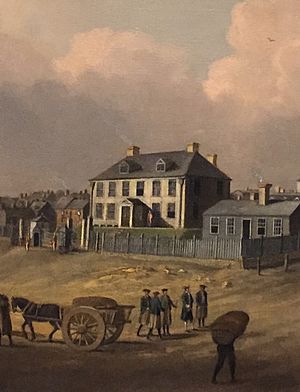Montague Wilmot facts for kids
Montague Wilmot was an important British leader in the 1700s. He served as the Governor of Nova Scotia, a British colony in what is now Canada. He passed away on May 23, 1766.
Contents
Early Life and Family Connections
We don't know much about where Montague Wilmot was born, but we do know it was in England. His father was a doctor for the Prince of Wales, who was a very important person in the royal family. His mother came from the Montagu family, and his uncle was George Montagu, a powerful Earl. These family connections likely helped Wilmot start his career as an army officer. He served in places like Gibraltar in 1745.
A Career in the Army
Wilmot's army unit was sent to Louisbourg, a fort that the French had given up to the British in 1745. This was an important time for the British in North America.
In 1749, Louisbourg was given back to the French. So, the British soldiers, including Wilmot, moved to Halifax, Nova Scotia. There, they served under Governor Edward Cornwallis. Many soldiers left Nova Scotia soon after, but Wilmot stayed. He had become a major, which is an important rank in the army.
In 1755, the British won a battle at Fort Beauséjour. A big war called the Seven Years' War had just started. Governor Charles Lawrence sent Wilmot, who was now a lieutenant-colonel, to command Fort Cumberland (the new name for Fort Beauséjour). In December 1755, he also joined the Nova Scotia Council, a group of advisors to the governor.
Later, in 1758, Wilmot was in charge of a group of soldiers in Louisbourg. In 1762, he was sent to Quebec.
Becoming Governor of Nova Scotia
In 1763, while he was in Quebec, Wilmot was chosen to be the Lieutenant-Governor of Nova Scotia. He took over from Jonathan Belcher.
Just one year later, in May 1764, Wilmot became the full Governor of Nova Scotia. This happened after the previous governor, Henry Ellis, resigned. It was a tough time to be governor. Nova Scotia had many problems, including a lot of debt.
By the time he became governor, Wilmot's health was already getting worse. He thought the climate in Nova Scotia was making him sick. He even asked to go back to England, but he never got an answer.
Governor Wilmot passed away in 1766 after a very difficult winter. A large funeral was held for him in Halifax. He is buried in the crypt of St. Paul's Church in Halifax.
Places Named After Wilmot
Several places were named to remember Montague Wilmot and his family:
- Fort Vieux Logis was renamed Fort Montague.
- Wilmot, Nova Scotia.
- Montague River on Prince Edward Island, which gave its name to the town of Montague.
- Wilmot Town (in Canso, Nova Scotia).
- Montague Street in Lunenburg, Nova Scotia.
- Montague Street in Saint Andrews, New Brunswick.



